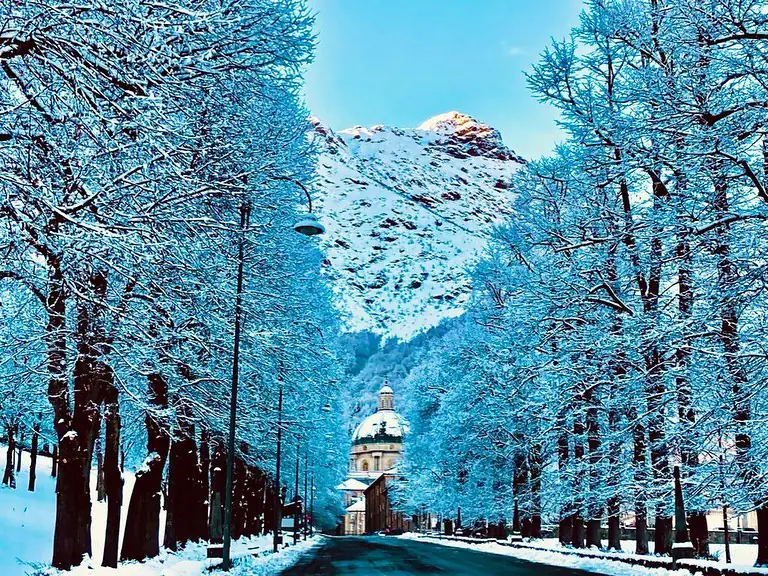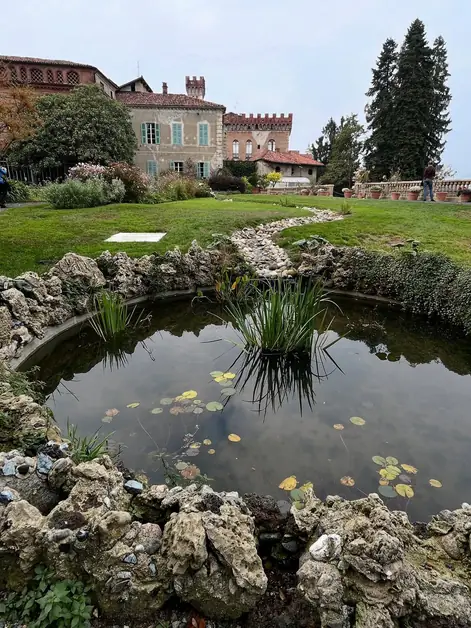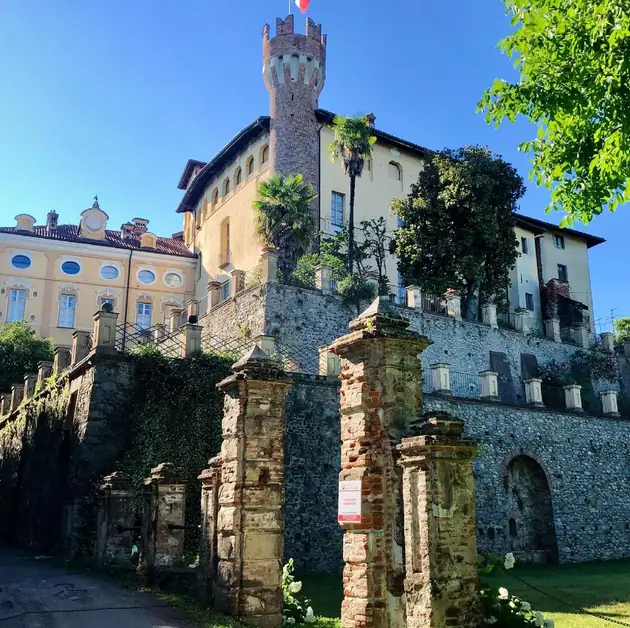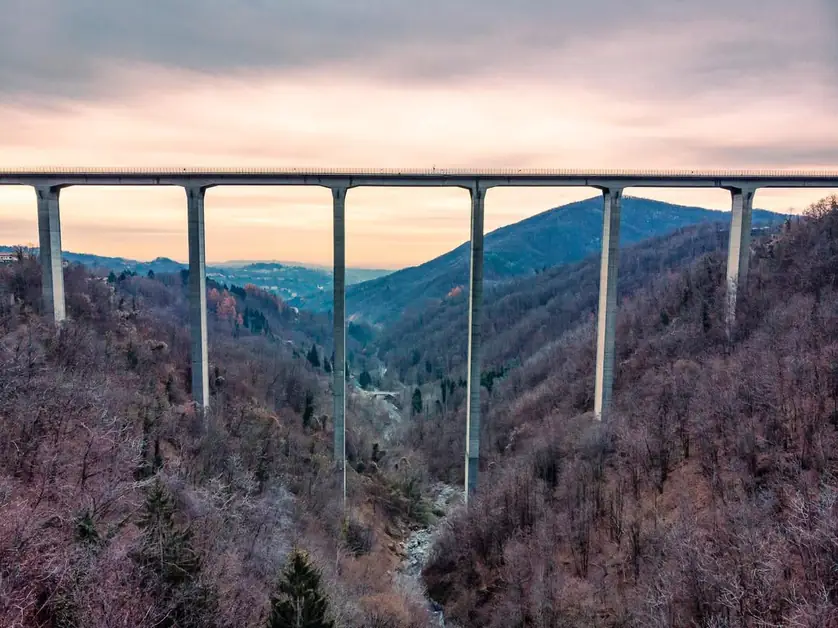Oropa between faith and nature an unforgettable journey
Oropa is a journey between spirituality and nature in every season.

Where is the Sanctuary of Oropa located?
The Sanctuary of Oropa is located about 12 kilometers from Biella, in the northern part of Piedmont, nestled in a natural basin among the Biella Alps. Situated at an altitude of 1,200 meters, it is one of the most important Marian sanctuaries in Europe and a place of great charm in every season. In winter, Oropa is often covered in snow, and the white that blankets the basilicas, porticos, and surrounding mountains creates a fairy-tale atmosphere, perfect for those who love the mountains and spirituality.
How to reach the Sanctuary of Oropa by car?
Reaching Oropa by car is simple. Starting from Biella, you follow the Provincial Road SP144, which gently climbs through beech and chestnut forests for about 12 kilometers. The route is scenic and well-marked, with wide curves and viewpoints where you can stop to take photos. Along the way, you will encounter small villages like Favaro and Sordevolo, where you can find typical restaurants and agritourisms. During winter, the road is generally clear thanks to snow removal services, but it is advisable to mount winter tires or carry chains, as the area can be subject to sudden snowfalls. Upon arrival at the sanctuary, there are ample parking areas both at the lower part of the complex and next to the main entrance. During peak times, such as holidays or religious events, additional parking and shuttles are organized.
Are there buses that go to the Sanctuary of Oropa?
Yes, Oropa is connected to Biella with a convenient bus service. The ATAP line 360 departs from Biella San Paolo train station and arrives directly at the sanctuary in about 30 minutes. The services are active all year round, with a higher frequency on weekends and during the summer. In winter, the service remains operational but may be subject to changes in case of heavy snowfall, so it is advisable to check the ATAP Biella transport company's website for updated schedules. For those arriving from other cities in Piedmont, Biella can be reached by train from Turin, Novara, and Milan, and from there it is easy to take a bus or taxi to Oropa.
Why visit Oropa in winter?
Visiting Oropa in winter is a unique experience. The snow-covered sanctuary conveys an even more intense sense of peace and reflection. The white roofs, statues, and snow-covered porticos create a postcard-like setting. Additionally, the surrounding mountains offer numerous activities for nature lovers: snowshoeing, winter walks, and photographic itineraries. Many pilgrims choose to visit Oropa in this season precisely for its suggestive silence and the magic of the winter landscape.
What is the history of the Sanctuary of Oropa?
The history of Oropa dates back to the 4th century when Saint Eusebius, Bishop of Vercelli, took refuge in these mountains bringing with him a wooden statue of the Virgin Mary. From that moment, the cult of the Black Madonna of Oropa spread throughout Piedmont. In the following centuries, the sanctuary grew to become a monumental complex with two basilicas, cloisters, porticoed squares, and hospitality structures. Today, the Sanctuary of Oropa is part of the Sacred Mountains of Piedmont and Lombardy, included in the UNESCO World Heritage list for their religious, artistic, and landscape value.
What to see at the Sanctuary of Oropa?
The sanctuary consists of several buildings distributed over different levels. In the oldest part, there is the Ancient Basilica, which houses the statue of the Black Madonna, an object of great devotion. Higher up stands the Upper Basilica, an imposing neoclassical structure completed in 1960, capable of accommodating thousands of worshippers. Also not to be missed is the Sacred Mountain of Oropa, a path immersed in nature that winds between 12 baroque chapels decorated with frescoes and statues depicting the life of the Virgin Mary. Finally, the Treasure Museum displays sacred objects, ex-votos, and historical testimonies related to popular devotion.
What can you do in Oropa during your visit?
In addition to the spiritual visit, Oropa offers many opportunities for discovery and relaxation. In winter, you can organize snow walks, snowshoe excursions, or climbs to the Mucrone Lakes and the Rosazza Refuge. Photography enthusiasts will find spectacular views, especially at sunset when the snow reflects the golden lights of the sun. The sanctuary also hosts musical events, exhibitions, and cultural meetings that combine art and spirituality. For the more athletic, the nearby Oropa cable car takes you up to Mount Mucrone, from where you can enjoy incredible views of Monte Rosa and the western Alps.
Where to eat and sleep at the Sanctuary of Oropa?
Within the Oropa complex, there are restaurants, cafes, and inns, perfect for a stop after your visit. You can taste typical Piedmontese dishes such as polenta concia, panissa, and mountain cheeses accompanied by local wines. Those wishing to stay longer can choose between the simple but welcoming rooms of the sanctuary or hotels and agritourisms in the surrounding area, ideal for those who love tranquility. In winter, sleeping in Oropa is a special experience: the snow, silence, and starry sky create an intimate and relaxing atmosphere.
What to do in the evening in Oropa?
In the evening, Oropa becomes a place of absolute peace. The lights illuminating the basilica and porticos create a suggestive contrast with the surrounding snow. Many visitors stop to attend the evening mass or take a silent walk in the main courtyard. Those staying here can enjoy the tranquility of the mountains or sip a warm drink in one of the sanctuary's inns. During the Christmas holidays, choral concerts and living nativity scenes are organized, making the atmosphere even more magical.
Why is the Sanctuary of Oropa an ideal destination for tourists?
Oropa is a place where spirituality and nature meet. It is perfect for tourists seeking authenticity, alpine landscapes, and local culture. The ease of access, architectural beauty, and the possibility of experiencing different activities in every season make it a complete destination. Whether covered in snow in winter or enveloped in greenery in summer, the Sanctuary of Oropa remains one of the most fascinating places in Piedmont, capable of welcoming everyone with its silence, history, and timeless beauty.


